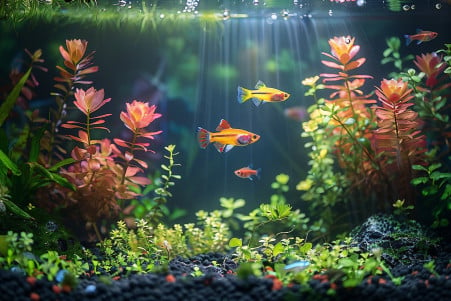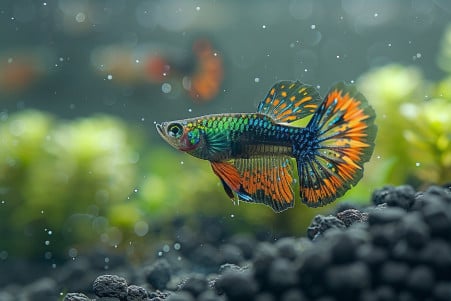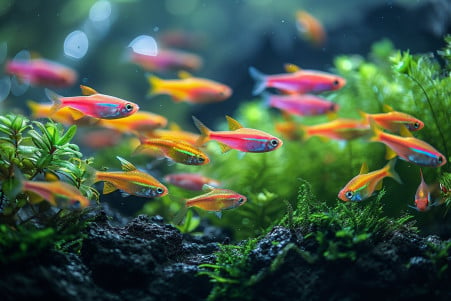Ideal Guppy Stocking: How Many in a 10-Gallon Tank?
17 February 2024 • Updated 16 February 2024

If you’re thinking about getting a 10-gallon tank for your guppies, the amount of space you have to work with is more important than you may realize. Most experts agree that you should have between 5–6 guppies in a 10-gallon tank to make sure they’re comfortable and to avoid overstocking.
To keep the peace and make sure you can handle the breeding that will inevitably happen, you should have one male for every 2–3 females.
This article will explore the ideal number of guppies for a 10-gallon tank by looking at a variety of topics in the world of aquatic research, including the guppy’s environmental requirements, behavior, space, and breeding.
We’ll also look at what expert aquarists have to say and what the science says to see how all of these things come together to determine the ideal stocking density. This information will help you make sure you’re setting up the best possible environment for your guppies, which is important for their well-being and longevity.
How many guppies can be ideally stocked in a 10-gallon tank?
What You Need to Keep Guppies Healthy
The first thing you need to keep guppies healthy is a clean environment. According to The Spruce Pets, guppies prefer water temperatures between 74 and 78 degrees Fahrenheit and a pH level between 7.0 and 7.2. To keep these levels consistent, you’ll need a good heater and a way to monitor the pH levels in the tank.
You also need a good filtration system. As noted by Modestfish.com, a good filtration system will help keep the tank clean by removing waste and other debris, and it will help maintain the nitrogen cycle in the tank.
The nitrogen cycle is important because it helps convert harmful ammonia and nitrite into nitrate, which is less harmful to fish. In addition to a good filtration system, you can also add live plants to the tank, as suggested by WikiHow, to help maintain a healthy bacterial environment and to help keep the water clean.
Guppies also need a good diet. When feeding your guppies, you should opt for micro pellets over flakes, as flakes can lose their nutritional value quickly. You should also feed your guppies small amounts of food once or twice a day to avoid overfeeding, which can lead to health problems and poor water quality.
Finally, while many people believe that guppies can be kept in overcrowded conditions, guppies need space to swim. According to PetMD, a 10-gallon tank can house about five guppies comfortably. This will give them plenty of space to swim and interact. Making sure you have all of these things is essential to keeping a healthy and happy guppy tank.
Guppy Social Behavior in the Aquarium
Guppies are also well-known for their social behavior, and they prefer to live in groups rather than alone. A study in Oxford Academic even found that guppies engage in social learning by following and copying the behaviors of their tank mates. This social learning is a result of the guppies’ natural tendency to live in groups and is an important part of their social structure.
This social structure is also important for their survival, as it helps them better understand their environment. However, the social structure of the group can also affect the group as a whole. For example, the male-to-female ratio is important, and if there are too many males, the group will become more aggressive and stressed.
In fact, a study in Scientific Reports found that guppies, even in the artificial environment of an aquarium, are motivated by the fear of predation and use it to form stable, differentiated social relationships.
When it comes to choosing tank mates for guppies, it’s important to make sure that the fish are compatible. The right combination of tank mates can help ensure that the guppies are able to live in peace, while the wrong combination can lead to stress and aggression.
As a result, it’s important to understand these social behaviors and how they affect the group as a whole, especially as we move into understanding their breeding patterns and how they affect stocking densities.
Guppy Reproduction: How to Control Birth Rates in Your Tank
Guppies are known for their prolific reproduction, and for good reason. Female guppies can produce multiple broods from a single mating due to their ability to store sperm for up to six months. This can lead to a population explosion in a 10-gallon tank, and it requires careful management to avoid overstocking and the stress it can cause to the tank’s ecosystem.
Aquarists can control the prolific breeding of guppies through selective breeding and other methods. By separating male and female guppies, aquarists can ensure that only planned breeding takes place, which can help prevent overpopulation.
As a study in the Proceedings of the National Academy of Sciences notes, female guppies that mate with multiple males produce larger broods with shorter gestation periods, and their offspring have better antipredator behavior. Knowing this, it’s important for aquarists to understand the factors that can help them control the breeding of their guppies so that the tank’s population is in line with the tank’s size and the needs of its inhabitants.
By controlling the breeding of their guppies, aquarists can find a balance between a tank that is both healthy and visually appealing and the needs of their guppy population, and avoid the potential problems that can come with overstocking.
Overstocked Aquariums: How to Avoid Them
When guppies are overstocked in an aquarium, their stress levels increase, which can lead to a decrease in their overall health—a problem that CO2Art.eu confirms, stating that overstocking can lead to poor water quality and increased fish mortality. Signs that an aquarium is overstocked include constant changes in water parameters like pH, cloudy water, and high nitrate levels, which can cause algae blooms and low oxygen levels.
This kind of environment can lead to stress-related diseases, stunted growth, and even death. To avoid these problems, aquarists need to keep an eye on the nitrogen cycle, change the water regularly, and make sure that the filtration system can handle the biological load. In addition, aquarists can ensure that the aquarium is a healthy environment by avoiding overstocking and following the space requirements for different fish species.
By respecting the balance of the aquarium and following the advice of experts, the guppies will be healthier and live longer, and the aquarium will be more beautiful. Understanding the importance of stocking densities is important to make sure that guppies are healthy, but it’s also important to think about the role of tank size in their well-being.
How Tank Size Affects Guppy Health and Behavior
The physical space that a tank provides is more than just a place to hold water; it also impacts the life that lives within it. For example, Case Western Reserve University notes that fish, including guppies, tend to show more aggression when they are in smaller, simpler environments. This means that a 10-gallon tank could be stressful for the fish if it’s not properly maintained.
Studies have repeatedly shown that fish need a certain amount of space to be healthy and happy in an aquarium environment. As tank size goes up, aggression goes down, which creates a more peaceful environment for the fish. This is further confirmed by research from ONEdersave that shows a significant drop in aggression as tank size increases.
These behavioral patterns are important to keep in mind when deciding how many guppies to keep in a tank.
For a 10-gallon tank, this means that the number of guppies needs to be balanced with the amount of space in the tank to ensure that the fish are as stress-free as possible, while also minimizing territorial disputes and allowing for natural behaviors.
In general, this means that guppy owners should aim to keep their fish in an environment that is as close as possible to the large, complex environments that they would encounter in the wild, which will benefit their physical and mental health.
Cultivating a Flourishing Ecosystem: Guppy Care in a 10-Gallon Tank
In the complex world of fishkeeping, knowing the ins and outs of guppy care in a 10-gallon tank is essential. From the number of fish to the male-to-female ratio, the tank size must meet the guppies’ environmental, social, and reproductive needs. Water quality, temperature, and pH, as well as diet and filtration, are the building blocks of their care.
From the social structure of guppies to their schooling behavior and the impact of overstocking, it’s clear that each of these factors is important to their overall health and well-being. While the space needed and the management of breeding are important, they’re not optional when it comes to maintaining a healthy guppy population.
At the end of the day, being a responsible fish keeper means balancing the beauty of the tank with the ethical need to create a healthy environment. In other words, the aesthetics of an aquarium should never come at the expense of the health of its living, breathing inhabitants.
By following these principles, a 10-gallon tank can be a place of balance and beauty, an affirmation of the best practices of responsible, caring guppy care.


